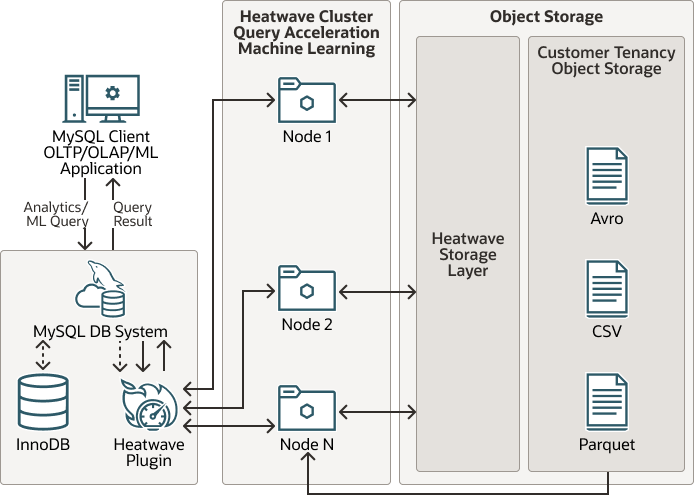The HeatWave architecture supports analytical processing, transaction processing, machine learning, and generative AI.
HeatWave stores data in main memory in a hybrid columnar format. The HeatWave hybrid approach achieves the benefits of columnar format for query processing, while avoiding the materialization and update costs associated with pure columnar format. Hybrid columnar format enables the use of efficient query processing algorithms designed to operate on fixed-width data, and permits vectorized query processing.
The HeatWave massively parallel architecture uses internode and intranode partitioning of data. Each node within a HeatWave Cluster, and each CPU core within a node, processes the partitioned data in parallel. HeatWave is capable of scaling to thousands of cores. This massively parallel architecture, combined with high-fanout, workload-aware partitioning, accelerates query processing.
HeatWave processes queries by pushing vector blocks (slices of columnar data) through the query execution plan from one operator to another. A push-based execution model avoids deep call stacks and saves valuable resources compared to tuple-based processing models.
When data is loaded into HeatWave, the HeatWave Storage Layer automatically persists the data for pause and resume of the HeatWave Cluster and for fast recovery in case of a HeatWave node or cluster failure. Data is automatically restored by the HeatWave Storage Layer when the HeatWave Cluster resumes after a pause or recovers a failed node or cluster. This automated, self-managing storage layer scales to the size required for your HeatWave Cluster and operates independently in the background. HeatWave on OCI persists the data to OCI Object Storage. HeatWave on AWS persists the data to AWS S3
As of MySQL 9.2.0, the HeatWave Storage Layer in OCI persists additional metadata to allow fast recovery after a planned or unplanned restart of DB systems.
Refer to the appropriate MySQL version to review in what cases the additional persisted metadata is used for fast recovery.
As of MySQL 9.2.0: Standalone DB Systems without High Availability for InnoDB and Lakehouse tables.
As of MySQL 9.2.1: DB Systems with High Availability for InnoDB tables only.
As of MySQL 9.3.0: DB Systems with High Availability for InnoDB tables and Lakehouse tables.
See HeatWave Cluster Failure and Recovery in the HeatWave on OCI Service Guide to learn more.
Native integration with MySQL provides a single data management platform for OLTP, OLAP, mixed workloads, and machine learning. HeatWave is designed as a pluggable MySQL storage engine, which enables management of both the MySQL and HeatWave using the same interfaces.
Changes to analytics data on the MySQL DB System are automatically propagated to HeatWave nodes in real time, which means that queries always have access to the latest data. Change propagation is performed automatically by a light-weight algorithm.
Users and applications interact with HeatWave through the MySQL DB System using standard tools and standard-based ODBC/JDBC connectors. HeatWave supports the same ANSI SQL standard and ACID properties as MySQL and the most commonly used data types. This support enables existing applications to use HeatWave without modification, allowing for quick and easy integration.
HeatWave uses statistics based on minimum and maximum values to automatically detect pruning opportunities and create zone maps. HeatWave then uses the zone maps for range and point queries to only scan data chunks that are relevant for the query. The result is a faster query because HeatWave can avoid data chunks that are not relevant. This is particularly useful for improving queries in OLAP and mixed workloads.
HeatWave automatically creates zone maps on primary key columns. As of MySQL 9.2.1, HeatWave tracks the workload and automatically creates zone maps for non-primary key columns as well.

